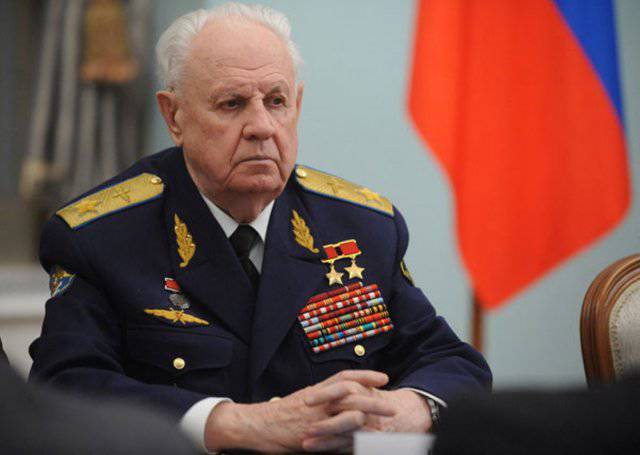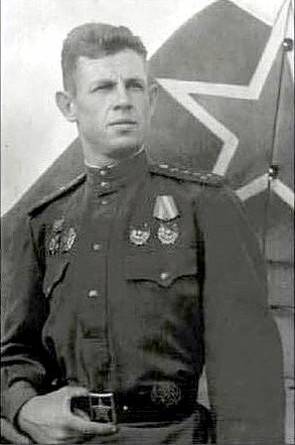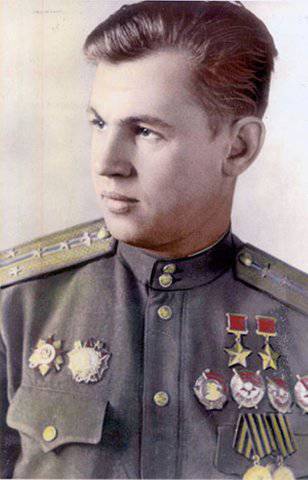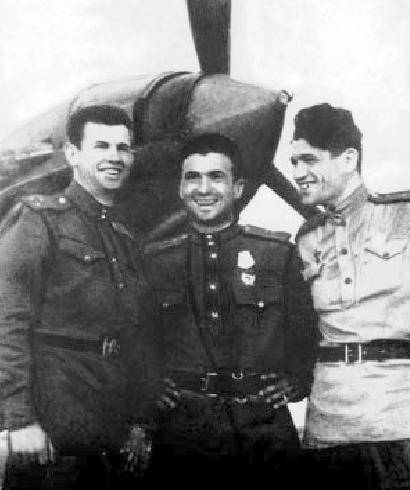Heavenly tankman

Alexander Nikolaevich was born 6 February 1923, in the Voronezh province in the village Kantemirovka. Their house stood on a quiet street near the Trinity Church. And behind the hut the meadow immediately began, and the river flowed in which the children swam and fished. The stepfather, Nikolay Gerasimovich, an engineer and a hereditary railway worker, educated the boy. The future pilot was given his last name, and from early childhood he considered a tall, strong man to be his own father. In total, their family had four children. The younger ones, Alexander and sister Lucy, were from the mother’s previous marriage, while the older Lisa and Kostya were the children of Nikolai. However, no one noticed the difference, all the children grew up like relatives. Fatherland for several decades worked as the head of the local distance path. Of course, he believed that his sons would follow in his footsteps. However, the life of Alexander Efimov was formed quite differently.
Once in their village a truly miraculous miracle happened. In broad daylight, a ski-equipped airplane made an emergency landing on a snowy pasture. Enchanted children and adults crowded around the plane until late at night. Then few people saw them even in the sky, but here it was possible to touch, touch the magic apparatus. And, of course, all the rural boys certainly decided to become pilots. Alexander and his stepbrother Konstantin have since played only “aviators”. And soon another propaganda plane visited the village. Guests gave the peasants leaflets and newspapers with stories about air navy. Specific tips on how to make flying models on their own at home fell into the hands of the children.
Over the years, the passion for aviation, the desire to visit the sky, Alexander only increased. In fairness, it is worth noting that Nikolai Gerasimovich supported his passion. Perhaps he felt that it would become the main business of Alexander. In the thirty-seventh year, the stepfather was arrested. For two years he suffered in prison, until he was finally acquitted. He returned to the family, but soon died. At the same time, the Efimovs moved from Kantemirovka to their mother's relatives in the Millerovo district center, located in the Rostov region. And the eldest son Konstantin went to study in the city of Voronezh. Alexander continued his studies in the seventh grade of the local school No. 2 and graduated from it in 1940.
Even during his studies, Alexander began to attend a school aviation circle, in which, together with other boys, he built the simplest aircraft with motors on elastic bands. Millerovo also had a glider school at Osoaviakhim equipped with a number of gliders such as US-4. In high school, Efimov worked there, mastering the theoretical part with interest, looking forward to independent flights. And the day came when they took place. 18 August 1938, Alexander Nikolaevich first took to the air. The feeling of flight, albeit at a low altitude, was indescribable. It was then that he firmly realized that he would become a pilot.
After the end of ten classes, Efimov had to choose his own further path. He was no different from other peers. Neither bogatyr physique, nor gigantic growth, nor outstanding intelligence. At first, Alexander tried to get into the naval aviation school. He passed the entrance exams with “excellent”, but the commission was outraged by the indicators of its weight. “Here you will gain three to four kilograms, you will mature, young man, then come to us,” they said. It was both disappointing and annoying, but Efimov did achieve his own, in May 1941, he entered first into the flying club, and only then into the military school for pilots located in Voroshilovgrad (Lugansk). The basics of the flight case of young aviators were taught on a plywood "duck" - the famous U-2 aircraft. Here he first met the Il-2 attack aircraft. One of the armor-crafted works of the outstanding designer Sergey Ilyushin changed the place of deployment and temporarily turned out to be on display in the flight strip of the airfield at Voroshilovgrad school. His form immediately struck Alexander. “He reminded me of a steppe eagle: mighty wings, a predatory nose, and the all-destroying power of fire,” Efimov said. The pilot of the aircraft told the assembled cadets about the merits of the new aircraft, was not too lazy to climb on it and show bombs, missiles, cannons and machine guns. And at the very end he took out a pistol and fired into the cabin. The bullet only scratched the armor.
22 June 1941, on Sunday early in the morning, a mother and a sister came to Alexander. “So, what kind of a pilot are you with us,” said the mother, when she saw the Efimov checkpoint coming out of the door in military uniform. At the end of the conversation, she said: "If only there was no war." However, the war was already on from four o'clock in the morning, but the inhabitants of Voroshilovgrad still did not know about it. For the first time, Alexander Efimov heard this truly black news, accompanying relatives home, at the tram stop.
 The first desire of Alexander, like many other cadets, was to immediately go to the front. However, the leadership of the school, gathering their pupils, managed to cool them down, explaining that the country needed well-trained pilots. And soon the whole Voroshilovgrad aviation school was evacuated to the Urals. Efimov's study continued, now the young aviator urgently retrained on the IL-2. This attack aircraft, called the “flying tank,” deservedly heads the honorary list of WWII airplanes that “have invested the greatest contribution to the victory” over Nazi Germany. Classes ended only in July 1942, after which Alexander Efimov, with the rank of sergeant, was immediately sent to the front. In the same year, A. Novikov was able to prove to Stalin the importance of the unification of aviation. However, the commanders of the ground forces achieved that all reforms in this direction were carried out only half. The aircraft was indeed assembled into the air armies, but was subordinated to the commanders of the fronts, thus limiting in maneuver. Only bomber aviation, which was transformed into long-range aviation, was directly subordinate to the Headquarters.
The first desire of Alexander, like many other cadets, was to immediately go to the front. However, the leadership of the school, gathering their pupils, managed to cool them down, explaining that the country needed well-trained pilots. And soon the whole Voroshilovgrad aviation school was evacuated to the Urals. Efimov's study continued, now the young aviator urgently retrained on the IL-2. This attack aircraft, called the “flying tank,” deservedly heads the honorary list of WWII airplanes that “have invested the greatest contribution to the victory” over Nazi Germany. Classes ended only in July 1942, after which Alexander Efimov, with the rank of sergeant, was immediately sent to the front. In the same year, A. Novikov was able to prove to Stalin the importance of the unification of aviation. However, the commanders of the ground forces achieved that all reforms in this direction were carried out only half. The aircraft was indeed assembled into the air armies, but was subordinated to the commanders of the fronts, thus limiting in maneuver. Only bomber aviation, which was transformed into long-range aviation, was directly subordinate to the Headquarters.Alexander was very lucky; he was assigned to the second aviation squadron 198 of the assault air regiment 233 of the assault aviation division. She acted on the Western Front, and was headed by Captain Viktor Malinkin, who was rightly considered one of the best commanders of her time. Even before the war, Malinkin worked as an instructor at the flying club, flew fighter jets, and then underwent retraining for an attack aircraft. It was thanks to his sensible advice and instructions that Efimov quickly got up and running. The first combat mission of nineteen-year-old Alexander Nikolayevich took place on November 30, 1942, in the Moscow region near the city of Rzhev. A squadron of stormtroopers struck at Osuga station, near which stood an enemy transport echelon. The combat mission was completed, the squad was bombed out, the railway tracks were turned around, the enemy suffered heavy losses. The young pilot was so happy with the success of the first flight that on the way back he lagged behind his group and lost his way over unfamiliar terrain. Efimov was lucky, he found a nearby airfield, where he refueled his fuel. And then he flew safely to his unit. There he was already considered dead, because by all accounts gasoline in the tanks was supposed to end. For such a misconduct, he received a severe reprimand from the squadron commander.
Anyway, by the beginning of the Battle of Kursk, Alexander Efimov had already become an experienced and skilled pilot. He was promoted to the rank, sent to combat missions leading air group. Soon he was entrusted with command of the link, and a little later (in the same 1943) squadron of attack aircraft.
 Later in his books, Alexander Efimov will tell in detail about the tactics of conducting air combat of Soviet attack aircraft during the war: “If no one could directly answer the question of Il-2 to resist the attack of enemy fighters, then no, he could not. In such a duel attack aircraft almost always lost. Yet the fighter plane is more maneuverable, and we were not prepared for a full-fledged air battle. And this is impossible. The purpose of attack aircraft is the enemy on the ground. Our only defense is group action. When attacking German fighters, a pair of our airplanes performed “scissors”. If the group was large, they covered each other, used a tactical maneuver “circle”. At the beginning of the war there were not enough fighters and we had to act without their accompaniment. To cover the strike groups used the so-called fighter attack aircraft, single IL-2 without bomb armament. Only experienced pilots flew them. The plane moved slightly away from the main group. When attacking enemy fighters, his task was not to get involved in a full-fledged battle, but to cut off the Nazis with fire from attack aircraft. When there were more fighters, this self-defense was removed. There was another method - the creation of special pairs for the destruction of enemy air defense systems. For example, of the eight attack aircraft, one pair worked only on the most dangerous anti-aircraft weapons. In general, our tactics changed, the whole war improved. At the very beginning we flew only at low level. It turned out to be very unprofitable: the angular movement of the target is large, you don’t have time to take aim properly with the help of a standard sight. Scopes for low altitude were absent, the pilots had to work out "by eye", or, as we said, "on the boot." Another negative side of flying at these altitudes is heavy losses. We were shot, if we speak figuratively, of all, even with pistols. Of course, the Il-2 armored capsule was designed to protect against small arms weapons, and from shell fragments.
Later in his books, Alexander Efimov will tell in detail about the tactics of conducting air combat of Soviet attack aircraft during the war: “If no one could directly answer the question of Il-2 to resist the attack of enemy fighters, then no, he could not. In such a duel attack aircraft almost always lost. Yet the fighter plane is more maneuverable, and we were not prepared for a full-fledged air battle. And this is impossible. The purpose of attack aircraft is the enemy on the ground. Our only defense is group action. When attacking German fighters, a pair of our airplanes performed “scissors”. If the group was large, they covered each other, used a tactical maneuver “circle”. At the beginning of the war there were not enough fighters and we had to act without their accompaniment. To cover the strike groups used the so-called fighter attack aircraft, single IL-2 without bomb armament. Only experienced pilots flew them. The plane moved slightly away from the main group. When attacking enemy fighters, his task was not to get involved in a full-fledged battle, but to cut off the Nazis with fire from attack aircraft. When there were more fighters, this self-defense was removed. There was another method - the creation of special pairs for the destruction of enemy air defense systems. For example, of the eight attack aircraft, one pair worked only on the most dangerous anti-aircraft weapons. In general, our tactics changed, the whole war improved. At the very beginning we flew only at low level. It turned out to be very unprofitable: the angular movement of the target is large, you don’t have time to take aim properly with the help of a standard sight. Scopes for low altitude were absent, the pilots had to work out "by eye", or, as we said, "on the boot." Another negative side of flying at these altitudes is heavy losses. We were shot, if we speak figuratively, of all, even with pistols. Of course, the Il-2 armored capsule was designed to protect against small arms weapons, and from shell fragments. Armored back twelve millimeters thick theoretically saved even from the attacks of enemy fighters. However, a direct hit of anti-aircraft shells broke through the attack aircraft armor. In order to escape from the fire of small-caliber anti-aircraft artillery - "Oerlikon" and large-caliber machine guns of the Nazis, we went up to eight hundred-thousand meters. Losses became less, productivity increased. Mastered, but this height did not suit us. You will only find the target, start the dive, take aim, and there is no time anymore, you need to bomb and set off for a second call. And in order to be more effective in attack, an attack aircraft should immediately bring down all its might on the enemy. Then they raised the height to another one and a half to two thousand meters, on which they ended the war. In one run, they had time to throw bombs, shoot "eRES" (missiles of the RS series), grind the enemy with cannon and machine guns. For the complete destruction of the goal managed to perform several visits. "
 Alexander Nikolaevich took part in the battles near Rzhev, Vyazma, Smolensk, Bryansk, fought in the airspace of Belarus, Poland, Germany. By July 1944, the senior lieutenant and commander of the squadron 198 of the assault Volkovyssky air regiment 233 of the assault air division of the fourth Air Army, AN Efimov made over a hundred successful combat and reconnaissance missions. October 26 of the same year for bravery, courage, heroism, military prowess and skill displayed in battles with the enemy, he was awarded the title Hero, and 18 August 1945 re-awarded the Order of the Golden Star. In the spring of 1945 th in the battles under the Polish city of Gdansk held its two hundredth flight. The last combat mission of Captain Efimov, already in the position of 62 navigator of the Guards Assault Aviation Regiment, was an 5 raid in May on the port of Swinemünde located in the Baltic Sea. May 9 Alexander Nikolaevich met in Berlin, along with his comrades signed the destroyed Reichstag and later took part in the Victory Parade.
Alexander Nikolaevich took part in the battles near Rzhev, Vyazma, Smolensk, Bryansk, fought in the airspace of Belarus, Poland, Germany. By July 1944, the senior lieutenant and commander of the squadron 198 of the assault Volkovyssky air regiment 233 of the assault air division of the fourth Air Army, AN Efimov made over a hundred successful combat and reconnaissance missions. October 26 of the same year for bravery, courage, heroism, military prowess and skill displayed in battles with the enemy, he was awarded the title Hero, and 18 August 1945 re-awarded the Order of the Golden Star. In the spring of 1945 th in the battles under the Polish city of Gdansk held its two hundredth flight. The last combat mission of Captain Efimov, already in the position of 62 navigator of the Guards Assault Aviation Regiment, was an 5 raid in May on the port of Swinemünde located in the Baltic Sea. May 9 Alexander Nikolaevich met in Berlin, along with his comrades signed the destroyed Reichstag and later took part in the Victory Parade.The war ended, but Alexander Nikolaevich could not imagine himself without aviation. In 1951, he successfully graduated from the Air Force Academy at Monino, and a few years later, at 1957, the Military Academy of the General Staff. An educated, competent officer with great combat experience began to move quickly up the career ladder. Soon, he commanded the assault air regiment, consisting of IL-10. After some time, he led the assault division on the MiG-17 and MiG-15, then the bomber division, equipped with IL-28. After graduating from the General Staff Academy, Alexander Nikolayevich was appointed deputy commander of the thirtieth air army stationed in the Baltic Military District. And from 1964 to 1969 years, he himself led the air army in the Carpathian Military District. In March, 1969, the new increase Efimov - now he is the first deputy commander in chief of the Air Force. At the beginning of the seventies, along with the assignment of the title "Honored Military Pilot of the USSR" Alexander Nikolaevich was sent to Egypt to fight with Mubarak. But his career growth does not end there, in 1975, he becomes Air Marshal, and finally, in 1984, Efimov holds the position of Commander-in-Chief of the Air Force - Deputy Minister of Defense of the USSR. In the same year, he won the State Prize for successful testing of new types of weapons.
Six long years worked Alexander Efimov as Commander of the Air Force. In 1990, he was appointed chairman of the special State Commission at the government for air traffic control and use of air transport. Also in the 1989-1991 years he was elected people's deputy of the USSR, a deputy of the Supreme Soviet of the USSR and the RSFSR. The Air Marshal retired in August 1993, but continued to work fruitfully for the good of the Motherland. Alexander Nikolayevich was a member of the Public Chamber of the Russian Federation, headed the committee of war veterans and military service, worked in the commission to establish interaction between reserve officers and veterans with public organizations.
In recent years, Efimov was deputy chairman (President of Russia) of the Victory Organizing Committee, President of the Victory-1945 International Charitable Foundation, and a member of the Central Council of the Ministry of Defense for Veterans' Affairs. In 2011, he participated in the signing of the Appeal of public representatives against the erosion of confidence in the judicial system of our country in the information environment. 31 August 2012, Alexander Efimov is gone. He died of a heart attack in the ninetieth year of life, presumably after he learned of the death of a close friend of Marshal S. Sokolov. September 4 Hero was buried in the Novodevichy cemetery.
All his life, Alexander Nikolaevich lived in Moscow, was married, father of four children. Without exaggeration, he laid the foundation of a whole dynasty of the Efimov aviators - his three sons and one grandson (so far) linked their lives with the sky. In addition, the legendary marshal was a member of the Academy of Sciences of Aviation and Aeronautics, a professor, a doctor of military sciences, the author of the books Above the Battlefield and the Soviet Air Force. He was awarded numerous foreign and domestic awards, including three orders of Lenin, five orders of the Red Banner, two - of the Patriotic War of the first degree, one - of Alexander Nevsky. The list of flight vehicles that Efimov already mastered in the post-war period is truly enormous, here are combat aircraft (IL-28, IL-10, Yak-11, Yak-9, MiG-21, MiG-17, MiG-15), and helicopters (Mi-4, Mi-1), and transport and passenger vehicles (IL-18, IL-14, An-24, An-14, An-8, An-2, Tu-134, Tu-124, Tu 104). Efimov reached almost a record flight longevity. Prior to 1983, he independently piloted the aircraft during numerous business trips around the country and even abroad. The last car he ran was the Tu-134. In one of the conversations with journalists, Alexander Nikolayevich was asked:
“What do you always tell your fellow soldiers at meetings?”
- Remember the war!
Information sources:
http://www.warheroes.ru/hero/hero.asp?Hero_id=1241
http://nvo.ng.ru/forces/2008-02-01/1_efimov.html
http://old.redstar.ru/2006/05/06_05/3_01.html
http://bookre.org/reader?file=107702

Information